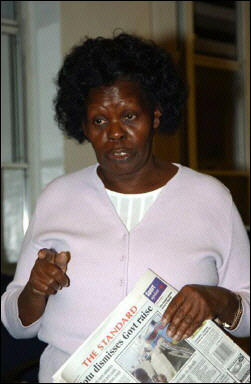
The U.N. Human Rights Council, frequently accused of coddling some of the world's most repressive governments, threw itself a party in Geneva on Tuesday that featured the unveiling of a $23 million mural paid for in part with foreign aid funds.


In a ceremony attended by U.N. Secretary General Ban Ki-moon, Spanish artist Miquel Barcelo told the press that his 16,000-square-foot ceiling artwork reminded him of "an image of the world dripping toward the sky" — but it reminded critics of money slipping out of relief coffers. "In Spain there's a controversy because they took money out of the foreign aid budget — took money from starving children in Africa — and spent it on colorful stalactites," said Hillel Neuer, executive director of UN Watch.


Spanish taxpayers paid for most of the sprawling sculpture, which has been compared to the Sistine Chapel, but around $633,000 came from Spain's budget for overseas development aid. Spain's conservative opposition party blasted the government for diverting money from projects to alleviate poverty in poorer countries, though the government insisted the funding for Barcelo's work was kept separate. Ban himself praised the piece and thanked Barcelo for putting his "unique talents to work in the service of the world." The artwork will soar above the Human Rights Council's chambers at U.N.'s European headquarters in Geneva, which may soon undergo a $1 billion renovation — but only after a $1.9 billion facelift of the U.N.'s New York offices is completed.

Meanwhile, international humanitarian groups pleaded with the human rights panel to take time out from their party to address the worsening human rights "catastrophe" in the Congo, where the government is fighting a deadly battle with several rebel groups. "Mass displacement, killings and sexual violence — involving hundreds of thousands of victims, if not more — require an urgent response," according to a statement issued jointly Tuesday by Freedom House and UN Watch. Congo has been off the radar at the Human Rights Council, which removed its monitor from the African country in March when the Congolese government and a group of neighboring nations applied pressure on the council to expel the monitor. "When the Human Rights Council was established two years ago there were about 12 or so monitors, and gradually one after another has been scrapped," said Neuer. "The other ones are all on the chopping block."
Violence is worsening in the country, where an estimated 4 million people have been killed in the past 10 years and tens of thousands have been displaced in recent months. "The [Lord's Resistance Army] leader, Joseph Kony, is continuing his brutal and abusive tactics," said Georgette Gagnon, Africa director at Human Rights Watch. "The U.S. and U.K., along with the UN and governments in the region, should actively work together to apprehend LRA leaders wanted by the [International Criminal Court]." Secretary-General Ban has supported a UN resolution that would increase the UN peacekeeping force in Congo by 3,100 troops and police, but some critics say that move would not be enough.
Human rights groups — and UN officials themselves — have criticized the peacekeeping force for failing to protect civilians in places like Kiwanja, where at least 20 people were killed this week. The 17,000-man UN deployment is already the UN's largest peacekeeping commitment, but is restricted by tough rules of engagement and has a massive territory to cover. Congo is the size of Western Europe, and North Kivu, where the fighting is centered, is one-and-a-half times the size of France.








Comments